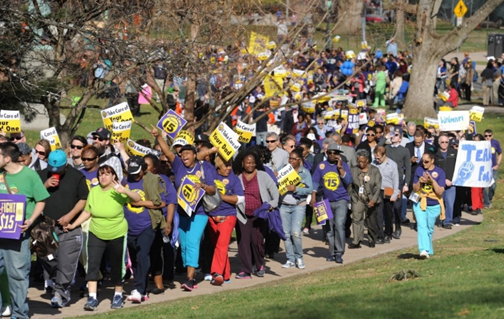As multiple planetary crises converge — the pandemic, lethal racial oppression, ecological destruction, plus an economic disaster shaping up to become this century’s Great Depression — every single state across the country is hurtling down the fiscal abyss. And there appears to be no end in sight. Facing astronomical revenue shortfalls, state governments have begun to slash services and lay off workers at a time when society obviously needs them most.
The origins of this budgetary emergency lie in the reign of austerity over the past half century, especially the lost decade of public sector investment after the Great Recession. During the longest economic expansion on record, most states failed to actually recover. On the contrary, state funding for health care, education, transportation, municipal aid, and the wider social safety net shriveled across the board. State and local workers now account for the lowest share of the workforce since the heyday of public sector union organizing in the 1960s.
You know how this story goes: instead of dying once and for all in the throes of the last crash, neoliberalism staggered on like a zombie. Exploiting the acute weakness of the labor movement and the Left more broadly, capital embarked on an organized offensive against the public sector in the states. Through formations such as the American Legislative Exchange Council, State Policy Network, and Americans for Prosperity, the billionaire class aggressively deployed a divide-and-conquer strategy to bust unions, implement antidemocratic measures, and lay the groundwork for Trump’s victory. The offensive had bipartisan reach but relied on the explosive rise of Republican governance in particular, as the balance between blue and red trifectas tipped from seventeen versus ten after 2008 to six versus twenty five after 2016. Joseph Lowndes and Daniel Martinez HoSang make a persuasive case that enduring tropes of “racial antistatism” juxtaposing (white) producers with (nonwhite) parasites helped animate the attack on public workers of every color.
It strains the imagination to think that the state budget crisis of the last decade will pale in comparison to the one we must confront in the next decade. But already we hear the familiar drumbeat from labor’s enemies: the call to tighten belts, restrict union rights, and cut or privatize programs. Though the future remains unclear, there’s no doubt that the affluent forces targeting unions and gutting the welfare state are ready to kick their efforts into overdrive.
How can the labor movement respond to this crisis — not merely to prevent an accelerating race to the bottom but to champion a social vision that dares to challenge the power of the ruling class and grow the power of the multiracial working class?
The View from Connecticut
Our union, SEIU 1199 New England (1199NE), is preparing to go on offense by helping to construct a strategic bloc in Connecticut that will fight for a People’s Recovery in the short run and for state-level political power in the long run.
Connecticut may be headquarters for the world’s largest hedge funds, capital of the insurance industry, and home to enough superrich residents to earn the nickname “the Gold Coast,” but the state never recuperated after the Great Recession. Endless budget deficits have compelled some to assert that we are in a “new economic reality” requiring shared sacrifice. An increasingly confident right wing — including Republican legislators, the Connecticut Business and Industry Association, and the Yankee Institute for Freedom and Public Policy — has scapegoated public sector unions for the state’s budget problems. Although a growing number of Democratic legislators are calling for tax increases on corporations and the wealthy in order to fund services that workers deserve, party leaders have remained hesitant or strongly opposed. Thus, austerity’s defenders have conjured the illusion that a state with the highest per-capita income is broke — rather than broke on purpose, to borrow the Chicago Teachers Union’s unforgettable slogan.
1199NE represents more than 25,000 care workers across the public and private sectors (or, more accurately, services that are publicly funded but privately operated). COVID-19 has revealed what our members have known all along: Connecticut’s chronic budgetary dilemma is intertwined with an outrageous maldistribution of resources. At the same time that essential workers — like our members, who are mostly women and people of color — are risking their lives on frontlines that have deteriorated from systematic underfunding and short staffing, the state’s seventeen richest billionaires collectively garnered $4.5 billion in profits.
1199NE members have already notched significant victories in the age of austerity: defending state worker standards, organizing home care workers into the union, and raising wages and benefits for nursing home and group home workers through repeated strike threats. But further advancement will require the greatest possible power in numbers among workers across the entire health care sector. Before the coronavirus outbreak, we committed to aligning contract expirations unionwide with the biennial budget session in the spring of 2021. The vast majority of our members will therefore take action (and threaten strikes) together in a moment when elected officials will be making crucial decisions about the future. Such unity hampers the anti-union ploy of pitting private sector workers against public sector workers.
The pandemic now raises the stakes even higher: our fight to demand dramatically higher standards for members is linked to the fight to demand a People’s Recovery for all workers across the state.
How Unions Can Lead Strategic Blocs
What exactly is the People’s Recovery? Unions and left organizations nationwide are beginning to raise similar sets of visionary reforms, though they’re using different names. No matter what you call it, the basic agenda consists of a few core principles. We must expand public services, relying on workers and communities to determine how; secure genuine worker relief through direct aid, debt cancelation, foreclosure moratoriums, jobs guarantees, and so on; enact policies to eliminate the structural inequalities of race and gender that decimate standards for all workers; and tax wealth to fund services by ending states’ highly regressive revenue structures. In short, unlike the bailout following the Great Recession, it’s time for a recovery which truly prioritizes the needs of working people, not the bottom lines of corporations, financiers, and the wealthy.
Fighting unions today are best positioned to lead this struggle due to their still formidable power as mass organizations. This is especially true in blue states like Connecticut, where unions are geographically concentrated. In fact, in nine of the ten states with the highest union density, Democratic trifectas rule. Here, the labor movement can join with allies on the Left in a united front to struggle for a People’s Recovery.
As the authors in the first issue of this journal brilliantly discussed, the Bargaining for the Common Good strategy has proved one of the labor movement’s most hopeful developments in many years. Teacher unions nationwide have shown the promise of using the strike weapon to join with community allies and broaden (and politicize) the scope of bargaining beyond wages and benefits. The Chicago Teachers Union and United Teachers Los Angeles have demonstrated perhaps the most sophisticated examples of this model.
In the approaching conflict over the shape of the recovery, let’s build on such electrifying breakthroughs and scale up this strategy by forging coalitions to contest state budgets.
Public worker unions can make common good demands on state governments in line with the principles of a People’s Recovery. At 1199NE, state worker delegates (elected stewards) are forming councils at the agency level in order to formulate these common good demands. This process taps into rank-and-file workers’ knowledge, passion, and original motivation for getting public service jobs. Addiction counselors, child psychologists, nurses, doctors, social workers, public health epidemiologists, and other members across state agencies can articulate the devastating consequences of austerity and identify concrete structural demands for the expanded care services our communities need today.
Meanwhile, we’re steadily assembling a wider coalition — because fighting unions must cultivate relationships with natural allies beyond the workplace and across the broad church of the Left. The last decade has featured the biggest activist eruptions in recent memory. A host of struggles have bloomed at the grassroots, from Occupy Wall Street to Standing Rock, from the Me Too movement to the growing socialist movement. Most significant of all, Black Lives Matter has generated mass opposition to state-sanctioned violence against Black and brown communities and revived the project to dismantle racial capitalism, root and branch.
In addition to unions, state-level coalitions fighting for a People’s Recovery could include:
-
Community Organizations. This encompasses a whole range of formations organizing for social justice.
-
Independent Political Organizations. The Working Families Party, the State Power Caucus, Our Revolution, and the socialist organizations affiliated with the Left Inside / Outside Project, all of which have made significant gains building independent political power.
-
Progressive Legislators. These are the state-level elected officials, most often emerging from the labor movement or the social movement Left, who can be counted on to consistently champion common good demands against austerity and structural racism.
Unifying these forces is an undeniably challenging project, even in states like Connecticut where coalition tables already exist. But the absence of a shared working-class platform severely limits what any single organization can win on even the most basic demands, not to mention the visionary demands outlined above. The need for labor unions and the Left to unite around such a platform is more urgent than ever.
Of course, the idea to revive working-class power by building bridges between unions and social movements is an old one with a venerable record. But we agree with Bill Fletcher Jr. and Fernando Gapasin’s key insight distinguishing labor-community alliances from strategic blocs. As they wrote on the cusp of the Great Recession, “A genuine labor movement would advance the notion of a social-political bloc whose goal is to achieve power. This power goes beyond bargaining power — whether in a specific workplace or even within a specific industry — to confer political-economic power in society as a whole.” In this moment of open possibility, we need strategic blocs that are built to last beyond any discrete budget session or contract campaign. The initial aim of these strategic blocs would be to fight for a People’s Recovery; the ultimate aim would be to develop the capacity to govern.
The Road Ahead
Out of the ferment of recent struggle, the contours of an ambitious social democratic program has emerged — and we’ve learned over the last decade that a remarkable swath of the population not only favors it but appears increasingly willing to take collective action to bring it about. The extraordinary events of 2020 have only offered further proof that the ideological ground is shifting beneath our feet.
But who can say how long this moment will last? Unless the labor movement and the Left overcome historic fragmentation, our apparently popular vision for a world of greater working-class power will remain a fantasy. It’s not enough to plant the flag. We need to consolidate the forces that have recently flourished and coordinate a shared struggle. To carry out the momentous work before us, we must rebuild the cross-organizational capacity we so desperately lack. Building strategic blocs to fight for a People’s Recovery in the states offers a concrete strategy to accomplish that task.


